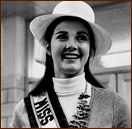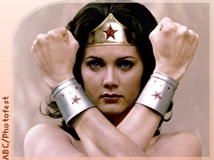
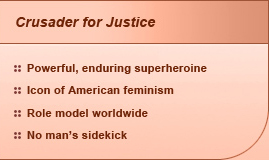
As Lovely as Aphrodite—as Wise as Athena—With the speed of Mercury and the strength of Hercules—she is known only as Wonder Woman, but who she is, or whence she came, nobody knows!
—All Star Comics #8
Decades before Buffy, Xena or the Bionic Woman, the ultimate twentieth-century alpha female bounded through storylines that explored feminism and politics, often with sexual overtones. Wonder Woman, the “Amazon Princess,” has long been a positive symbol of feminine strength.
Male comics heroes such as Superman and Batman were very popular in the 1940s. Wonder Woman creator William Moulton Marston, an educational consultant for DC Comics with degrees in psychology and law, knew it was time for a female to step into the male-dominated world of superheroes. In his own words, “Not even girls want to be girls so long as our feminine archetype lacks force, strength and power. ...The obvious remedy is to create a feminine character with all the strength of Superman plus all the allure of a good and beautiful woman.”
The Ultimate It Girl
Wonder Woman made her debut as secretary of the Justice Society in the December 1941/January 1942 issue of All-American’s All Star Comics. In January 1942, Marston and artist Harry Peter created the first Wonder Woman cover at her new home, Sensation Comics. By that summer, she had her own comic book. By 1944, Wonder Woman had a circulation of more than 2.5 million.
As Marston catered to the desires of DC’s overwhelmingly male audience (90 percent), he introduced them to the power of a stunning, independent woman who could kick their behinds!
Wonder Woman’s story borrows its roots from Greek mythology. She is Princess Diana, the daughter of Queen Hippolyta of Paradise Island, a man-less, utopian island of Amazons created by Aphrodite.
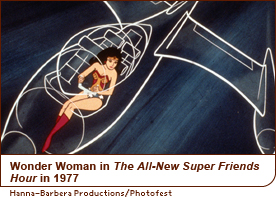 In Wonder Woman #1 (Sensation Comics, Summer 1942), Mars inspires Hercules to instigate war against the Amazons. Aphrodite saves the Amazons from enslavement and sends them to live on Paradise Island, separated from the world and men.
In Wonder Woman #1 (Sensation Comics, Summer 1942), Mars inspires Hercules to instigate war against the Amazons. Aphrodite saves the Amazons from enslavement and sends them to live on Paradise Island, separated from the world and men.
When Major Steve Trevor, an American pilot fighting in World War II, crashes on the uncharted Paradise Island, Princess Diana rescues him. Transfixed by this man, Diana learns of the war he is fighting against the Nazis. The Amazons hold a contest to determine who will go with Steve to help fight the evildoers. Diana wins and leaves Paradise Island for America, disguised as Trevor’s secretary, Diana Prince.
Unlike many DC superheroes, Wonder Woman is a trained soldier, warrior and politician. She possesses powers unlike any of her counterparts’. Her Lasso of Truth compels captives to honesty. Her Venus Girdle endows her with superhuman strength. Her signature bracelets deflect bullets. Her tiara doubles as a boomerang. And her invisible plane can fly undetected by the human eye.
Wonder Woman’s enemies are some of the oddest in comic-book history. In addition to fighting criminals, spies, Nazis and Martians, at one point she fights an evil incarnation of herself. Other foes of note include the green-skinned Crimson Centipede; Hephaestus, who transforms human emotion into fire; the Mole Goldings, a subterranean race that wants to change the world into solid gold; Queen Clea of Atlantis; Doctor Poison, a Japanese princess who specializes in chemical warfare; Cheetah; and Dr. Psycho, a woman-hater who can impersonate anyone.
Since Marston’s death in 1948, the fictional world of Wonder Woman has endured many changes, often reflective of changes in the broader culture. After World War II ended, the storylines turned from fighting Nazis to romance. Through the years, a series of editors and artists have added their own styles, sometimes straying far from Marston’s original. The consistent figure has been Wonder Woman herself, who has been entertaining readers for over 60 years.
From Page to Screen
Wonder Woman is to me—as she is to so many women of all ages—a symbol of all the glorious gifts that reside in the spirit of woman.
—Lynda Carter
There have been many attempts to bring Wonder Woman to life beyond the pages of comic books. Here is a short chronology:
1966—Wonder Woman Goes Vinyl: A 45 rpm record is released in the form of a radio play.
1967—The Shorter the Better: A four-minute short film entitled Wonder Woman: Who’s Afraid of Diana Prince? stars Ellie Wood Walker, the first woman to ever play Diana Prince.
1974—Blondes Don’t Have More Fun: Far-from-brunette actress Cathy Lee Crosby stars as the Amazon princess in the unpopular ABC TV movie of the week, Wonder Woman. Viewers complained about the poor adaptation of the original plot and Crosby’s lack of resemblance to the comic-book heroine.
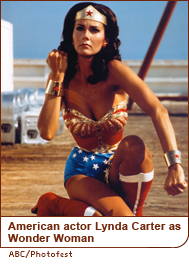 1975—Birth of a TV Icon: ABC debuts The New Original Wonder Woman, starring newcomer Lynda Carter in the title role. Its success inspires two more TV movies.
1975—Birth of a TV Icon: ABC debuts The New Original Wonder Woman, starring newcomer Lynda Carter in the title role. Its success inspires two more TV movies.
1976—It’s a Pick-Up!: ABC launches Wonder Woman as a weekly TV series, with hour-long storylines about fighting Nazis that hark back to the original comic.
1977—The Wonder Makeover: CBS acquires ABC’s Wonder Woman and adapts the storyline to modern times, renaming the series The New Adventures of Wonder Woman.
The CBS series lasted only three seasons, but for many people, Lynda Carter remains the visual icon of Wonder Woman, and the series is considered a significant chapter in pop culture. The world’s favorite Amazon still graces the small screen in the animated series Justice League, which airs on the Cartoon Network, and the first complete season of Wonder Woman is available on DVD.
Social and Cultural Trailblazer
Wonder Woman was born during World War II, the era of Rosie the Riveter. There were labor shortages nationwide and an unprecedented number of women were working full-time jobs, many of which were usually reserved for men. As women gained more financial independence, they also experienced more freedom.
Before the publication of Wonder Woman, most women in comic books were relegated to minor roles, primarily playing the male hero’s sidekick. The introduction of Wonder Woman was profound. She was beautiful, independent and a humanist—a positive symbol of feminine strength. 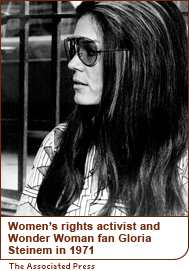
Marston was a pioneer in introducing feminist ideas to his male readers through the entertaining adventures of an alluring female heroine. “The fact that both sexes are beginning to recognize the desire for the supremacy of strong and loving women is by far the most hopeful sign of the times,” he said in 1942.
Wonder Woman became a role model and icon for women and later for feminists. The cover of the 1972 debut issue of Ms. magazine featured an image of Wonder Woman and the headline “Wonder Woman for President.” The magazine’s founder, Gloria Steinem, noted, “Looking back now at these Wonder Woman stories from the forties, I am amazed by the strength of their feminist message. Wonder Woman symbolizes many of the values of the women’s culture that feminists are now trying to introduce into the mainstream.”
For more than 60 years, Wonder Woman has embodied the same core values and self-respect as powerful and wondrous real women. As Wonder Woman said to one of her male foes, “I’ll still have the last laugh! Anything you can do, I can UN-do better!”
:: Susan Leslie
Read More About Wonder Woman





